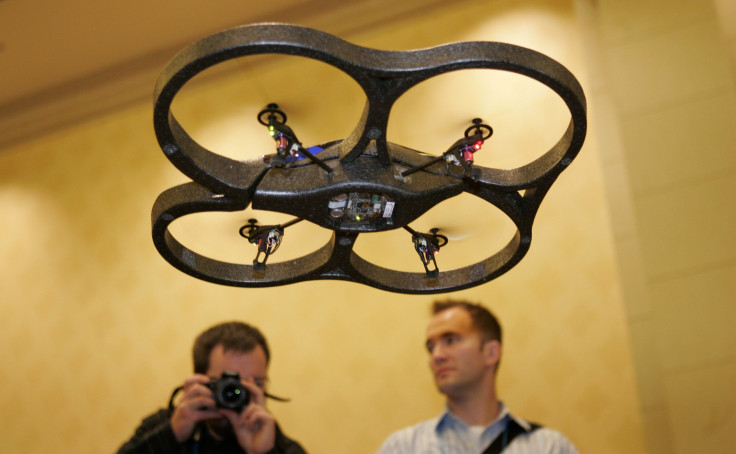How To Buy A Drone: Everything You Need To Know About Prices, Specs, Cameras And Legal Status

The drones have arrived. Like it or not, legions of unmanned aerial vehicles are already buzzing through residential streets, over public parks and even crashing onto the White House lawn. It's not just big players like Amazon and the U.S. military pushing drone technology, though, as private companies scramble to meet public demand.
Action camera maker GoPro became the latest to enter the race for drone dominance when CEO Nick Woodman announced Wednesday the company will release its own quadcopter (a drone with four rotating propellers) early next year. Woodman's announcement was scant on details but anyone with two thumbs and an extra $1,000 can see that GoPro should expect some competitive turbulence. Here's everything you need to know before the next consumer fleet takes off.
There's Already A Selfie Drone For Sale
Wannabe action stars are fawning over the Lily drone, which was made available for preorders earlier this month. This UAV isn't scheduled to be released until February but it's currently the only product that promises to film users by following them around based on a GPS signal attached to their wrist. A demo video released by Lily has only increased the fervor, with users salivating over the idea that they won't have to pilot the craft while filming themselves. The biggest drawback? The battery life is expected to be only 20 minutes, which makes for a short mountain bike ride. Preorders cost $499, with the price doubling to $1,000 when the Lily is released.
But Don't Forget About The DJI Phantom 2
Almost every conversation about camera drones begins and ends with the DJI Phantom. There's the DJI Panthom 2 Vision +, available with a camera attached for $1,299 and the DJI Phantom 2 at $679 without a camera, though it works with a GoPro. DJI Phantom is the best-selling line of drones on the market, and chances are that if you've seen a drone zipping through the park or a drone-filmed video online it came from one of these.
The sleek UAV is easy to use right out of the box, with a controller unit and a range extender that strengthens a user's Wi-Fi signal so you can watch the drone's camera through your smartphone midflight. It hovers steadily in place and is controlled by two joysticks that seem inspired by early video game consoles. There's also a “home lock,” a GPS feature that automatically returns the Phantom to its point of origin if a pilot loses sight of it.
Of course, none of that really matters if you crash the Phantom into a garage door.
Or, You Can Get A Starter Drone On The Cheap
Rookie drone operators concerned about slamming their new UAV into a telephone pole shouldn't need to worry about their savings going down, too. A range of drones can be bought for less than a few hundred dollars. Sure, they're not going to compete with the DJI Phantom, but they're a heck of a lot easier to replace for pilots calling mayday.
UDI U818A $51.99 on Amazon. This quadcopter has a flight duration of under 10 minutes and a charging time of about 120 minutes. Still, it comes with strong power motors that aim to resist strong winds and there's a small camera that enables first-person view. It can fly within 30 meters of the drone operator.
Blade Nano QX RTF $52.53 on Amazon. The Blade Nano has been cited by multiple reviewers as the drone that gives you the best bang for your buck. The craft is as small as they come, weighing in at barely more than half an ounce, and can be piloted through the smallest areas. Did someone tell you you can't fly your way out of a paper bag? Here's a chance to prove them wrong.
Blade FPV Nano RTF QX Quadcopter $419.99 on Amazon. This is Step 2. Along with acting as a souped up version of the Nano, this drone comes with a headset that gives a pilot a first-person view of what they're doing up in the sky. It's also just fun – the Blade FPV Nano comes with a stability mode and agility mode that lets operators either soar comfortably at cruising altitude or master barrel rolls that would make the Blue Angels nervous that their time has passed.
Drone Laws Are Still Developing
Drones are here to stay but for what purpose is still up for debate. The Federal Aviation Administration released the B4UFLY app in May to remind recreational drone pilots that they're subject to a still-evolving set of safety guidelines. Users are required to fly no higher than 400 feet, no faster than 100 mph and are asked to remain beneath surrounding obstacles whenever possible. You'll also be responsible for keeping your aircraft within your line of sight at all times, and avoid flying over individuals or “vulnerable property” whenever possible.
Not Everyone Will Think Your New Toy Is Cool
Don't be surprised if, upon flying over unsuspecting pedestrians, people offer the middle finger more often than a friendly wave. Most Americans, 63 percent according to a recent Pew Research Center poll, think it would be a change for the worse if “personal and commercial drones are given permission to fly through most U.S. airspace.”
Drones will almost certainly become an invaluable tool for search and rescue missions, natural mapping, exploration and commerce. But groups like the Electronic Frontier Foundation and the American Civil Liberties Union have maintained that things could worsen before they improve. UAVs set loose without proper regulation could enable forms of surveillance that the ACLU warned might “cause unprecedented invasions of our privacy rights.”
© Copyright IBTimes 2024. All rights reserved.





















